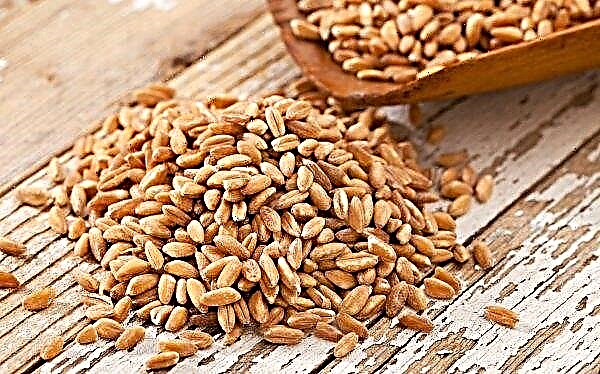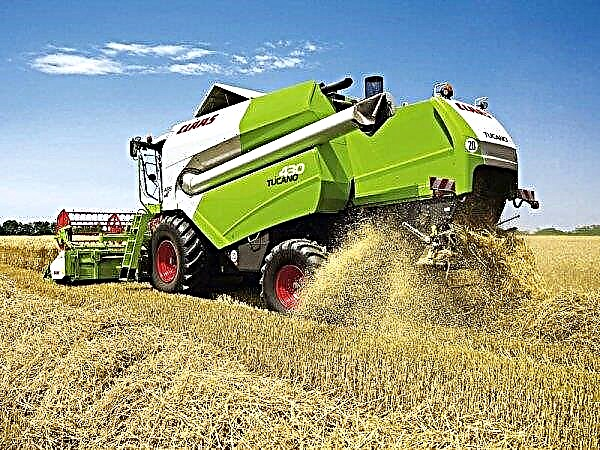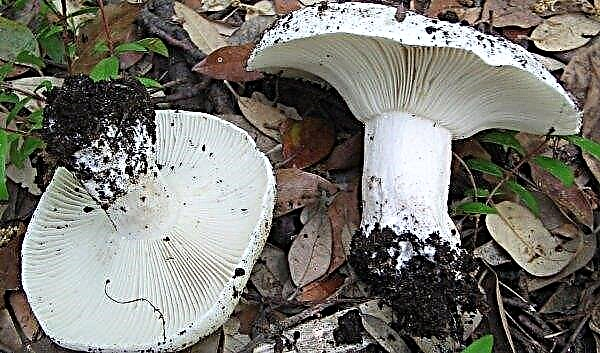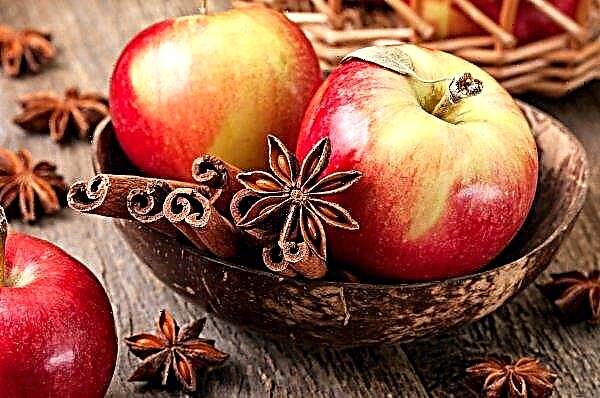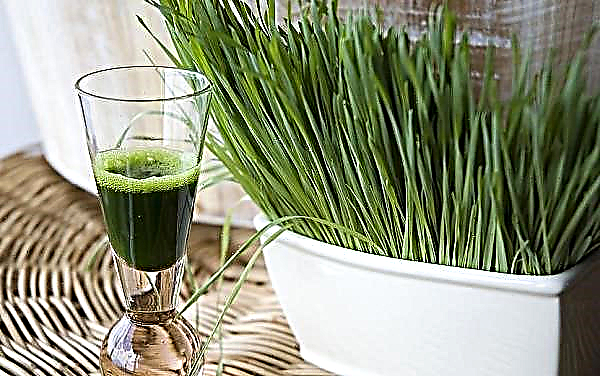An excellent option to keep cabbage until spring without losing its taste and marketability is considered to be storage of cabbage in a cling film. Let's look at which varieties have a high percentage of keeping quality, and what other methods exist for keeping the vegetable fresh.
Varieties of cabbage suitable for long-term storage
Today there are many varieties of cabbage, which have their own advantages and disadvantages. However, not all of them are suitable for long-term storage. The best types of vegetables, with excellent keeping quality, are considered mid-ripening and late-ripening hybrid forms, which are characterized by a rather long vegetation period. They have dense, hard heads of cabbage, which are equally well suited for long-term storage at home, and for the preparation of various blanks, preservation.
Did you know? In Japan, cabbage is used not only in the culinary field. Some varieties are specially grown for decorative purposes, they are decorated with flower beds, flower beds, and parks.
For winter bookmarks, it is recommended to give preference to such varieties of cabbage, such as:
These varieties are the best among the other "relatives", they have good resistance to temperature jumps, moisture and other negative external factors.The basic rules for storing cabbage in the winter
Long-term storage of the vegetable involves observing several important rules that allow you to save fresh cabbage until spring:
- Temperature. Both high and low temperature indicators in the room negatively affect the condition of heads of cabbage. Cabbage prefers stable temperatures, the range of which varies from 0 to + 2 ° C. A slight increase to + 4 ° C is allowed. At sub-zero temperatures, forks run the risk of freezing, and as a result, rotting. At too high temperatures, + 5 ° C and above, heads of cabbage become an ideal source for the development of pathogenic organisms and infections.
- Humidity. No less important for long vegetable stall is humidity, the optimal level of which should be 85–95%. Too dry air can cause the heads to dry out, and a moisture level of more than 95% will lead to rapid rotting of the fruit.
Important! By maintaining the temperature and humidity levels at the required level, cabbage can be preserved up to 8–10 months.
Places and storage methods
Basements and cellars are considered traditional places for storing cabbage for the winter. However, few people know how to preserve the vegetable in a home or apartment. And for this, there are several simple alternative methods.
In cling film
Storage of cabbage in a food film is one of the easiest and most affordable, since it does not take much time and hassle. All that is needed in this case is to stock up on a roll of cling film 35–45 cm wide. Pre-prepared heads of cabbage are wrapped in three or four layers, while the material is smoothed to the surface of the vegetable as tightly as possible. Among the advantages of this method can be noted:
Among the advantages of this method can be noted:
- simplicity in execution;
- availability;
- low cost of the necessary materials.
The disadvantage of such storage is the need for regular inspection of forks for damaged, rotten areas. Only fully healthy, dense, resilient heads of cabbage are to be stored, without damage, cracks, rotten and infected places, with fresh and strong leaves.
Important! It is impossible to wrap in a film initially loose, with visible damage to the plug.
With vegetables, you need to cut the leg as close to the base as possible. Before wrapping properly, it is recommended to rinse the cabbage under running water and dry thoroughly. Forks wrapped in stretch are placed in drawers or on shelves.
In fridge
The refrigerator is the most affordable place in the apartment for storing cabbage. Heads of cabbage are placed in compartments for vegetables or on shelves in the refrigerator. Heads of cabbage can be wrapped in cling film or white paper, which will protect them from drying out the top layer of leaves. In the refrigerator, cabbage is able to maintain taste and marketability for 3-4 months. A significant drawback of “cold storage” is the limited area, because many heads of cabbage can not be accommodated in one refrigerator.
In the refrigerator, cabbage is able to maintain taste and marketability for 3-4 months. A significant drawback of “cold storage” is the limited area, because many heads of cabbage can not be accommodated in one refrigerator.
In the freezer
If there is no cellar or basement for storing cabbage, it can be frozen in the freezer. However, many housewives are interested in the question, can this be done? As you know, a vegetable negatively reacts to cold, through which it loses its crisp structure, presentation, becomes lethargic and soft. Therefore, when deciding to freeze the heads of cabbage, you need to be prepared for the fact that after defrosting, cabbage leaves are not suitable for all dishes, for example, preparing a fresh, crispy salad will not work.
The advantages of such storage are:
- long shelf life of the product;
- profitability;
- preservation of all nutritional valuable qualities of a vegetable;
- the presence of a vegetable is always "at hand".

Other methods
Harvested cabbage harvested for winter consumption can also be preserved by other alternative methods.
In drawers
It is convenient to store vegetables on the balcony, cellar or basement in drawers. Although this method is considered very affordable, it is not the most effective, as it requires regular “ventilation” of the crop.
Important! Boxes are not advised to be placed on the floor. It is better to store them on a small pallet or stand.
For him:
- Heads are laid before laying, the top layer of leaves is removed, the leg is cut.
- The forks are placed in one tier in a container so that they do not come into contact with each other.

In paper
Instead of plastic film, wrapping heads is allowed in plain, unprinted paper, such as parchment. Pre-cleaned, washed and dried head of cabbage wrapped in paper in a couple of layers. You can use newspapers for wrapping, however, for the first inner layer should be exclusively white paper.
Wrapped heads of cabbage are further stored in boxes, racks or shelves. The paper layer will protect the plugs from the cold, moisture or lighting, and will also serve as a barrier against contact between heads of cabbage.
In clay
An unconventional method of preserving vegetables is considered to be their treatment with clay solution.
For this:
- A water-clay solution is prepared by mixing two parts of clay and one part of water. The mixture should, by consistency, resemble thick sour cream.
- Pre-cleaned from the top layer of leaves, washed, dried, healthy heads of cabbage are coated with a rather thick layer of clay and allowed to dry.
- Spoiled forks are placed in nets and suspended.
In this form, cabbage can be stored until the end of February.
Digging cabbage in the sand
Burying vegetables in sand makes it possible to significantly reduce the risk of crop loss, and extend their viability as long as possible. To implement this method, follow these instructions:
To implement this method, follow these instructions:
- The head is cut out of the head as much as possible under the leaves.
- Forks are placed in a wooden container so that they do not touch the surfaces.
- The first layer of cabbage is completely covered with dry sand.
- Spread the second layer on top, do the same manipulations.
- The container is completely filled with the product.
Important! For the instillation method, only well-dried sand should be used without fail. In the wet sand, the cabbage will begin to rot.
In the grid
Heads of cabbage are allowed to be kept in nets. To do this, choose the most healthy, tight, strong forks, free from the upper layer of leaves, cut the stump and put them in nets. At the same time, the nets are suspended in the cellar to provide them with good ventilation. You can lay nets on wooden pallets, however, with such storage, their contents will need to be regularly reviewed for rotten, damaged areas.
In the cellar
Before laying vegetables, create comfortable conditions for wintering:
- disinfect walls, ceilings, shelves and racks for the prevention of fungal and bacterial infections;
- dry the room;
- to carry out activities that exclude the appearance of rodents and parasites.
Did you know? Not far from France, on the island of Jersey, an unusual variety of cabbage grows, the leaf length of which reaches 3-4 m. Although the foliage of the vegetable is edible, it is rarely used by local residents. They mainly use the stems from which they make interior items and furniture.
It is allowed to lay cabbage in the cellar:
- in wooden or plastic boxes;
- save in the form of a pyramid on a special platform of wood;
- deepen in the sand;
- store in a wrapped form (film or paper);
- in limbo.
 With the safety of products, it is recommended to provide indoor temperature parameters at a level from 0 to + 4 ° C, and humidity - about 90%. In addition, heads of cabbage should have access to fresh air and not be in contact with each other.
With the safety of products, it is recommended to provide indoor temperature parameters at a level from 0 to + 4 ° C, and humidity - about 90%. In addition, heads of cabbage should have access to fresh air and not be in contact with each other.Tips for keeping cabbage in winter so that it stays fresh and juicy until spring
To prolong the freshness and preserve the juiciness of cabbage, when it is preserved, it is recommended to be guided by several simple tips:
- with any storage method, it is advised to regularly inspect the heads of cabbage for damage, rot, mechanical damage. When sorting vegetables for further storage for the winter, one should, without sparing, remove dry, rotted leaves from the heads of cabbage. Even slightly damaged forks can provoke decay and damage to the entire crop;
- on heads of cabbage, it is imperative to cut the stalk as deep as possible, otherwise it, with long stubbornness, will begin to grow, form small forks, thereby depriving the main vegetable of moisture;
- adhere to the room where cabbage is stored, the optimal conditions of temperature and humidity;
- in case of loss of marketable vegetables, they should be processed immediately;
- walls, floor and ceilings in the room should be as dry as possible, without damage by rot, fungi or mold;
- Before you send the cabbages “for the winter”, it is recommended that they be soaked for 15 minutes in salt water and dried thoroughly. Such manipulations can protect the plugs from infections, as well as retain moisture in them;
- with any storage method, cabbage needs regular ventilation, several times a month.
Cabbage is a vegetable that is extremely rich in vitamins and mineral components required to ensure the normal functioning of the human body. However, to keep the forks fresh and juicy for a long period, they need to provide comfortable storage conditions. Fortunately, today there are many simple and affordable ways that make it possible to enjoy a healthy product until spring.

